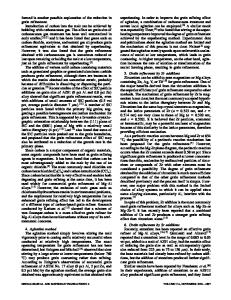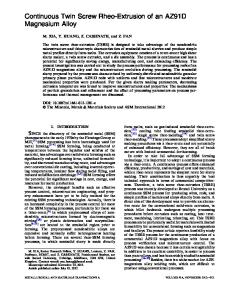Effects of Processing Parameters on the Grain Refinement of Magnesium Alloy by Equal-Channel Angular Extrusion
- PDF / 764,050 Bytes
- 11 Pages / 593.972 x 792 pts Page_size
- 87 Downloads / 359 Views
ON
THE ability to produce bulk ultrafine-grained metals by equal-channel angular extrusion (ECAE), also called equal-channel angular pressing, has garnered a tremendous amount of attention over the last decade. The literature reflects the many attempts that have been made to investigate the factors responsible for the grainrefinement process in ECAE. The amount of plastic strain that is imposed on a billet is an important processing parameter for the production of ultrafine-grained metals. For fcc and bcc metals, by continuously imposing plastic strain, grains are gradually refined. The refinement process is achieved through the continuous subdivision of the original grains by dislocation walls, e.g., References 1 through 3. This process proceeds homogeneously over the entire billet. For aluminum, as the imposed plastic strain is increased, dislocation walls gradually transform into grain boundaries; meanwhile, misorientations across the boundaries are increased.[4] For copper, due to its low stacking-fault energy, the transformation of dislocation walls into grain boundaries is difficult,[5–7] but misorientations across the boundaries still increase with increasing strain. Apart from the imposed plastic strain, the channel angle, F, is another important processing parameter that can influence the grain-refinement process. The first and most systematic study of the influence of the die angle on grain refinement was published by Nakashima et al.[8] Their results suggested that the smaller the die angle, the more effective the grain-refinement process. The process route has also been reported to have a significant effect on the grain-refinement process.[2,9,10] S.X. DING, Research Student, and C.P. CHANG and P.W. KAO, Professors, are with the Institute of Materials Science and Engineering, National Sun Yat-sen University, Kaohsiung, 80424 Taiwan, Republic of China. Contact e-mail: [email protected] Manuscript submitted May 8, 2008. Article published online January 6, 2009 METALLURGICAL AND MATERIALS TRANSACTIONS A
Through detailed analysis of the extruded microstructure of aluminum by transmission electron microscopy (TEM), Sun et al.[9] reported that route Bc is the most effective route in terms of grain refinement. Extrusion at elevated temperatures can prevent the cracking of hard materials and thus improve the workability of a billet.[11] When the extrusion temperature was increased, the minimum attainable grain size was found to be increased and the fraction of high misorientation boundaries was found to be lower.[12–14] The workability of a billet was reported to be improved significantly by using a low extrusion speed to process titanium and 4340 steel.[11] The extrusion speed was reported[15] to have no influence on the grain size of aluminum and its alloys subjected to ECAE. Despite the fact that the aforementioned conclusions were mainly drawn from the experimental results involving fcc metals, they appeared to be widely accepted in the literature regardless of the crystal structure of the material being processed. Over
Data Loading...











